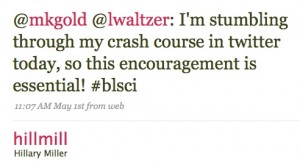At the BLSCI Symposium last week (see the previous post for more info), I had the good fortune to work a bit with Gardner Campbell, including attending his afternoon workshop titled “Speaker, Listener, Network: The Concept of Audience in a Web 2.0 World”. The main thrust of the talk was that Web 2.0 technologies, and in particular the phenomenon of open APIs and the mashups they allow, call into question our notion of what constitutes the (or even an) audience for the content that we produce. It is through the lens of the author that one can really see this at work.
Here’s how I would reconstruct the argument. Communication – I’m thinking primarily here of linguistic communication, but it could be the case with other kinds of conventionalized communication as well – works because of a set of assumptions that the author (a term I might for the moment apply broadly to anyone who “authors” an utterance with communicative intent) has about his audience. If I say “Gee, it’s cold in here” because I want you to close the door, I am assuming, among other things: that you are a sufficiently competent speaker of English, that your hearing is functioning properly, that you will grasp the “literal” meaning of my sentence (i.e. that the ambient temperature in the room is too low for my comfort), that you will assume that I must have uttered the sentence not just to inform you of my beliefs regarding the temperature of the room but to make you close the door, that you like me well enough to want to make me more comfortable, that you are physically able to close the door. And so on, ad nauseum. More generally, the communicative gesture that an author chooses to make (a gesture like an utterance) will depend on his beliefs about who or what his audience is. (None of this is very new or very original, of course.)
We might think of certain kinds of authorship, such as writing a book or painting a picture, as less direct than the kind of authorship described in the foregoing paragraph, because the author is separated further from his audience and, as a result, has less information about them. When I write a book entitled Gee, It’s Cold In Here, I make some of the assumptions discussed above, but some I do not. Using Twitter is probably something like this, as you might be justified in making some assumptions about your audience (you know the handles of your followers, for instance), but it’s impossible to judge the potential scope of this audience, or to know many details about most of them.
When an author’s work is mashed up after the fact, his connection to his audience is so indirect that you might call it altogether disconnection. I might send a tweet, something like “boonebgorges: Gee, it’s cold in here”, with the intent to get a rise out of my Twitter followers. Let’s say it gets pulled into Twistori (perhaps the tweet should have been “I hate how cold it is in here”…). Think about the people who now view this tweet in its new context. Not only do I not know who they are, but I had never really even considered the possibility of their existence when authoring the original tweet. In this sense, whatever assumptions I had originally made about my audience have been entirely subverted by the reuse of my work. There is a sense in which I am no longer the author of what I wrote: I didn’t code Twistori, I didn’t conceptualize the potential visitors to twistori.com, etc. As with any remix – from DJing to quilting to objet trouvé art – the idea of authorship being vested in a single individual has been overthrown (if it was ever that simple even in the case of more traditional authorship).
Once authorship becomes decentralized, so too does audienceship. Let’s say that you are one of my Twitter followers. You saw my initial tweet in its original context, in your Twitter timeline. Let’s imagine further that you are checking out Twistori at some later date and see my tweet repurposed in the Twistori timeline. Who, at that moment, is the audience for my tweet, and why? Are you the audience, because the tweet was originally written with you in mind? Are you the audience, because you’re now reading the tweet on Twistori? Is no one the audience since no one can be definitely picked out? There is a certain amount of self-selection that has to happen; the reader must construct an audienceship around himself. Reading a disembodied, mashed-up tweet written by a stranger, you could imagine yourself as a friend of the original tweeter, as a viewer of a piece of abstract art, or any number of other things. When you get enough people – enough intentional actions – between you and the original producer of the content, you have to make decisions for yourself about what kind of audience you are a part of, if any.
Anyway, this is all very interesting to me, and I have some thoughts about whether there are – or should be – any “right” answers to the questions of how to circumscribe authorship and audience. I need some more time to think about that, though.

